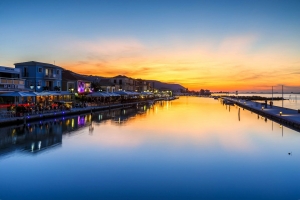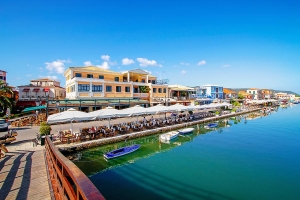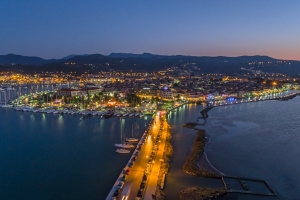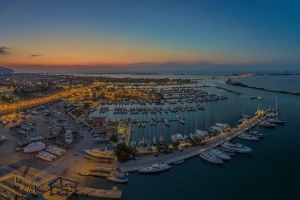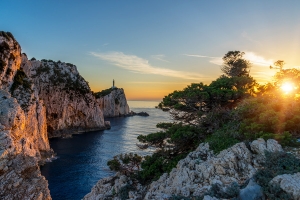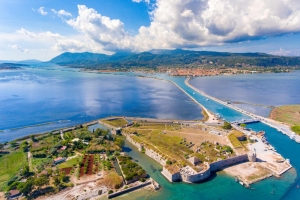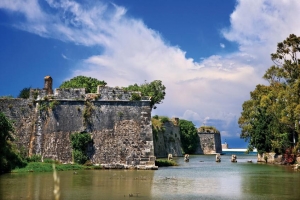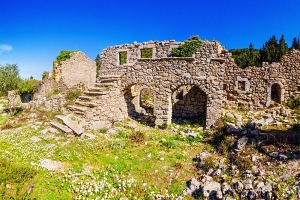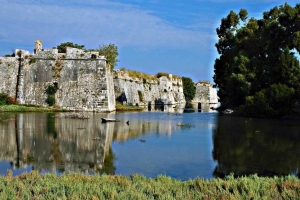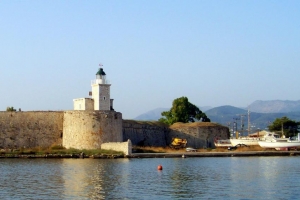Lefkada Villa Corina, Lefkada Luxury Apartments.
Lefkada is surrounded by a number of smaller islands, Kalamos, Kastos, Meganisi as well as a group of islands known as Prigkiponisia, to which belong the private islands Scorpios, Madouri and Sparti. Due to its geographical location, it is connected to Etoloakarnania by a floating bridge and the access to the island is by car, easily and inexpensively.
Lefkada is famous for its sandy beaches with clear blue waters, such as Kathisma and Porto Katsiki and for its picturesque fishing villages and mountain villages. It offers night entertainment, sports activities such as windsurfing but also sightseeing spots, such as the Venetian Castle of Agia Mavra, the Cape Lefkatas and the Waterfalls of Dimosari.
Access
Lefkada benefits from easy access as it is connected with the mainland by a floating bridge. The underwater tunnel of Preveza-Aktion offers easy access to the island from northwest Greece and the port of Igoumenitsa (100 km), which is a major gateway for Western and Central Europe. Visitors from North Greece can easily reach Lefkada by Egnatia. Arriving in Ioannina follow the route to Preveza where the underwater tunnel.Lefkada Villa Corina, Lefkada Luxury Apartments.
The distance from Action Airport to the island of Lefkada is 22 km. The bridge of Rio-Antirio facilitate the connection of the island with Greece, and the port of Patras (170 km), which is the second major gateway to Europe.
History of Lefkada
The myth about Sappho’s suicide at Cape Lefkada is related to other myths linking the island to the ancient Greek goddess of love, Aphrodite, and to Odysseus, the hero of Homer’s Odyssey. The German archaeologist Wilhelm Dörpfeld, having performed excavations at various locations of Lefkada, was able to obtain funding to do work on the island by suggesting that Lefkada was Homer’s Ithaca, and the palace of Odysseus was located west of Nydri on the south coast of Lefkada. There have been suggestions by local tourism officials that several passages in the Odyssey point to Lefkada as a possible model for Homeric Ithaca. The most notable of these passages pushed by the local tourism board describes Ithaca as an island reachable on foot, which was the case for Lefkada since it is not really an island, that it was connected to the mainland by a narrow causeway. According to Strabo, the coast of Acarnania was called Leucas in earlier times. The ancient sources call Leucas a Corinthian colony, perhaps with a Corcyraen participation.During the Peloponnesian War Leucas joined the Spartan Confederation.
Lefkada was part of the Despotate of Epirus until 1295 when it passed from Despot Nikephoros I to his son-in-law John Orsini. The Castle of Santa Maura, which eventually gave its name to the island, was first built in the beginning of the 14th century; the possession of the castle was key to holding the island. The Orsini family lost Lefkada in 1331, to the Angevins. In 1343, Walter of Brienne granted Lefkada and the Santa Maura castle to Venetian Graziano Giorgio. Between 1343 and 1348, Serbian ruler Stefan Dušan invaded Albania, Epirus and Thessaly, conquering all except for Vonitsa and Santa Maura. In 1362, Leonardo I Tocco seized Lefkada and Vonitsa. In 1479, the Ottomans took Lefkada, and rebuilt the castle on a large scale (the core of the castle being Ottoman).Lefkada Villa Corina, Lefkada Luxury Apartments.
The Venetians briefly held Lefkada between 1500 and 1503, during the Ottoman-Venetian War, after which it was returned to Ottoman rule by peace treaty. Ottoman rule was interrupted by Venice in 1684, with the Ottomans surrendering it after a 16-day siege, and was thus again part of the Ionian Islands under Venetian rule.
The Ottomans called it Ayamavra, from Greek Agia Maura (Αγία Μαύρα meaning “Santa Maura”), and ruled it between 1479–1502, 1504–1684 and 1715-1716. The Venetians extensively modified the castle in the early 18th century, and the British also made some modification in the 19th century.
In 1800, the Septinsular Republic was established, a Russian protectorate under de jure Ottoman suzerainty. The Russian Empire employed troops recruited from fugitive klephts and armatoloi in the Ionian Islands, particularly of Lefkada. Among these were captains Anastasios Tselios and Apostolos Levendakis, the latter who already in 1802 offered to raise a company of 60 fighters on Lefkada to support the Russians. In 1815, Great Britain set up the United States of the Ionian Islands as a protectorate which lasted until 1864, when the islands were ceded to Greece. One of the seven island states was Lefkada.Lefkada Villa Corina, Accommodation in Lefkada

